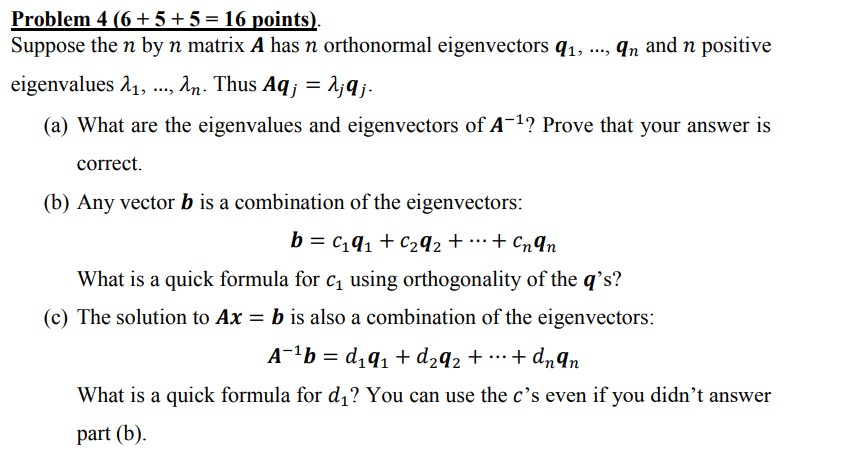P4

\[Aq_j=\lambda_jq_j\to q_j=\lambda_jA^{-1}q_j\to A^{-1}q_j=\frac{1}{\lambda_j}q_j\](a)
(b)
利用 $q_j$ 的标准正交性, 两边同乘 $q_1^T$
\[q_1^Tb=c_1\](c)
同 (b) 两边同乘 $q_1^T$
\[d_1=q_1^TA^{-1}b=q_1^TA^{-1}\sum c_iq_i\]Since $A^{-1}q_j=\frac{1}{\lambda_j}q_j$, 注意题干里是给了 $\lambda_j$ 作为已知的
\[d_1=q_1^T\sum\frac{c_i}{\lambda_i}q_i=\frac{c_1}{\lambda_1}\]P6
Let \(A=I-cE=\begin{bmatrix} 1 & & \\ & 1 & \\ & & 1 \\ \end{bmatrix}-c\begin{bmatrix} 1 & 1 & 1 \\ 1 & 1 & 1 \\ 1 & 1 & 1 \\ \end{bmatrix}\)
(a) 找到 $c$ 使得 $A$ 为 projection matrix
$A$ 为 projection matrix $\iff A^2=A$ 像这样的在证明复合矩阵运算时, 不妨就拆开来算, 即证 $(I-cE)^2=I-cE$, 这要比直接证明 $A^2=A$ 要简便的多
(b) 找到 $c$ 使得 $A$ 为 orthogonal matrix
Orthogonal matrix 的定义是 $A^T=A^{-1}$ or $A^TA=I$, 也就是说, orhogonal matrix 是由 orthonormal vectors 构成的, 而不是 orthogonal vectors
\[I=A^TA=A^2=(I-cE)^2\](c) 找到 $c$ 使得 $A$ 为 diagonalizable matrix
Since $A=A^T$, $A$ is always diagonalizable
\[Ax=\lambda x\to A^{-1}x=\frac{1}{\lambda}x\](d) Find eigenvalues of $A^{-1}$ in terms of $c$
To find $\lambda$, we need to find the eigenvalues of $I, E$. For $I$, $\lambda_I=[1,1,1]$; For $E$ \(\begin{cases} &\text{rank}(E)=1,E\text{ is symmetric}\to E\text{ has one non-zero eigenvalue} \\ &\text{tr}(E)=\sum e_{ii}=\sum \lambda_i=3\to\lambda_E=[3,0,0] \end{cases}\)
Therefore, \(\lambda=\lambda_I-c\lambda_E=[1-3c,1,0]\)
(e) 找到 $c$ 使得 $A$ 为 positive definite matrix
由 (d) 可知, 只需使得 $1-3c>0$ 即可满足正定
Document Information
- Author: Zeka Lee
- Link: https://zhekaili.github.io/0001/03/05/LA-Math415-final-review/
- Copyright: 自由转载-非商用-非衍生-保持署名(创意共享3.0许可证)